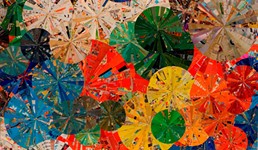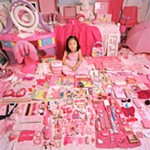Collecting as Affliction
Art Lover Philip Dempsey Just Can't Shake the Bug
By Rebecca S. Cohen, Fri., Aug. 22, 1997
"I wonder if it comes with instructions," he muses. He bought the sculpture by David McManaway after seeing its image on a color postcard invitation and after Betty Moody sent him photographs of the other works in the show. This Austin collector doesn't travel out of town very often and hasn't seen the actual work before today. Dempsey consults the postcard now to be certain that he's arranged the components correctly. On the rectangular, 10-inch-long black base, a round glass globe with a bright yellow rose inside stands next to a black ceramic figure of a woman wearing a long skirt and a cowboy hat. There are yellow dots painted all over the figure and a tiny holstered gun glued to her hip. The diminutive sculpture is called, predictably enough, Yellow Rose of Texas. If he can find a place in his small house -- already dense with collectibles of one kind and another -- to hang the new rodeo photograph near this particular sculpture, the resulting commentary on Southwestern womanhood will be delicious. Set near the realistic landscapes and the horse and rider pictures that Dempsey collected originally, it will be possible to witness the evolution of Texas culture as well as the changing visual sensibilities of Philip Dempsey.
These two new works form a bridge from his earliest collecting to the more recent works that appeared at the Nancy Scanlan Gallery at St. Stephen's School in an exhibition curated by Chuck Cooper. Dempsey's art collection now includes modest Western-style paintings by lesser artists, a complete collection of magazine prints by Frederick Remington that appeared in Harpers Weekly during the Forties, all but one of the Vargas gate-fold illustrations of women that appeared in Esquire in the Forties, one carousel horse, paintings of women (often nude) by Texas artists Alma Hartline, Dan Allison, Jimmy Jalapeeno, and James Johnson, and a fair number of works by the artists who appear in Annette Carlozzi's Fifty Texas Artists published 15 years ago. McManaway's sculpture is the most recent addition to this last category. Dempsey shows off his copy of Carlozzi's book, marked to identify which artists are already included in his collection. Contemporary Art in Texas, by Patricia Covo Johnson of Houston, also provides direction for his art acquisitions. The urge itself -- to collect art and cookie tins, books on history, and Southwestern belt buckles -- he attributes to the example set by various family members. "One of my uncles is a pack rat, and my mom used to collect dishes and glassware." He gestures around the dark paneled living room and kitchen which are indeed filled floor to ceiling with china, Depression glass, and cut glass goblets as well as comfortable furniture, art, books, and a number of painted wooden objects crafted by Dempsey himself. His reference to family idiosyncrasies provides a glib and hauntingly incomplete explanation of how a 45-year-old man who has been content to live his life with a small circle of friends and loved ones, within a circumscribed area of Texas, has developed such a passionate interest in and appreciation for contemporary art. A serious commitment of money, albeit often paid out over long periods of time, has been made. "I don't have too many other vices," he says to explain the seemingly endless string of purchases.
Regarding his attraction to the visual arts, he says, "I had scarlet fever when I was in the first grade, and that's how I lost [some of my] my hearing and my ability to speak clearly." In fact, he has no trouble making himself understood, but Dempsey has worn a hearing aid since he was a child. "Maybe I became more visual when I couldn't hear as well," he suggests. Maybe Lubbock, which has turned out a number of fine musicians and artists, has produced talented, heretofore unheralded art collectors as well. My tall, denim-clad host with black hair, black-rimmed glasses, and black cowboy boots shrugs when I suggest the possibility.
Some of Dempsey's earliest acquisitions in Austin came from the now defunct Eagle's Nest Gallery, where he got to know owner Blake Tollett. He recalls that it was Tollett's assistant Elizabeth Hansing (now director of fine arts at St. Stephen's School) or perhaps Tollett himself who first suggested that he visit AIR Gallery at 12th and Lamar. At AIR he met Chuck Cooper, who introduced him to a broader (and more raucous) assortment of work by contemporary Texas artists than he'd seen at Eagle's Nest. Dempsey, who can be reticent around new acquaintances, was no doubt overwhelmed by Cooper's ebullient style. He was intrigued by the art. Cooper became his mentor.
Since then he has bought art through Chuck Cooper and Lyons Matrix Gallery and Galeria Sin Fronteras here in Austin and from Moody Gallery in Houston. Except for occasional trips to Paris, Texas, where he was born, Dempsey doesn't venture much beyond Austin. After working as a draftsman, he was laid off by his company about five years ago and then re-hired by the same company as a security guard. He works the night shift now, interfacing in the twilight hours and days off with his father and sister who live with him. In 1972, when he and his father, sister, and mother -- who has since passed away -- moved to Austin, horses grazed not all that far from their house and drank in a nearby creek. A lot has changed in the intervening years, inside and out. His neighborhood is now an endless maze of houses without horses grazing nearby. Horses and riders figure less and less in his collection. When asked if his family is sympathetic with his current taste in art, he says that his father prefers cowboys and realistic landscapes, and that his sister doesn't have any "collector genes" at all. "A cousin or two understand where the collection is going," he says, "[and] I don't hang the risqué [pictures] out in front."
Dempsey made a fine attempt to explain his personal perspective on collecting art to a larger audience for the St. Stephen's exhibition. His picture appeared next to the other Austinite whose collection was featured, Clint Boelsche, on a small brochure that was available in the gallery, and he wrote a brief description of what draws him to certain images:
Color and movement are important. But the ways in which an artist portrays universal emotions through the human figure is central to my collection. Some pieces tell stories. Some pieces are pure emotion.
Was it difficult for him to gather his thoughts? "It was like writing a high school book report," says Dempsey, who is nonetheless clearly pleased with the result. He seems equally pleased with the places where his collection and Boelsche's intersect visually. They both own work by Susan Whyne, Melissa Miller, Robert Levers, and Gail Stack, and together their collections represent a broad cross section of artists working in Texas, yet their approach to collecting is completely different. Boelsche seems interested in social change. Dempsey's statement in the brochure continues: "Sometimes I smile at the human condition. I smile because I've been there or because I could have been there or because I very well may be there someday." He raises his eyebrows and smiles. "I'm a pretty easygoing guy."
What is it that drives easygoing Philip Dempsey and fellow Austinites Clint Boelsche and Chuck Cooper to surround themselves with art? Certainly it has nothing to do with decorating fine houses or impressing the folks next door. How do their impulses to own objects overlap those of Lucy Lippard or the Vogels, a postal employee and his wife, whose collection of minimalist art will visit Austin in the fall before it is housed permanently in the National Gallery in Washington, D.C.? What motivates these collectors-without-castles, anyway? I asked, but Boelsche and Cooper were hard pressed to provide answers. Dempsey mentions the word "affliction," as if collecting were some kind of disease. Similarly, in the summer issue of ARTnews, which was devoted to collectors, Barbara Pollack writes, "The collecting bug can strike indiscriminately, and while the causes are hard to determine and the symptoms vary, everyone agrees there is no cure." Possibly the impulse to collect runs akin to the impulse to create art, similarly obsessive behavior.
I've come to believe that there are two kinds of people in this world, and one kind has sticky fingers. From the time they're children, they hold on to photographs, pieces of paper, books they might want to revisit, pebbles from a favorite stream, shells from the beach, stamps, coins, even empty matchbooks from restaurants long since closed. They hoard postcards or snow globes or posters to remind them of trips they've taken or trips that friends have taken. They organize or catalogue the objects they save. I recently visited an artist whose home was filled with little baskets of beads, buttons, pebbles, dried flowers. These pretty objects weren't being reserved for future use but for the ongoing pleasure of the eye, to somehow soothe the soul. Art collectors gobble up and arrange art objects in the same way. They begin with one, but then they see a relationship between two objects that engages them, and then a third expands the dialogue. They compare and contrast one artist's work with another. They purchase and compare multiple works by the same artist. In this way, collectors not only take in works of art by others, they bring into being something new by assembling these objects. Collectors, like curators, devise unique installations and ideas using artists' work as their medium. The "success" of these new installations depends less on the financial resources of the collector than on his or her eye and ability to intuit and articulate relationships. Finally, collecting, like making art, develops a momentum of its own; it defies explanation. There is only restless enthusiasm and waiting for the next image to arrive.
Rebecca S. Cohen is an arts writer and recovering art dealer.








